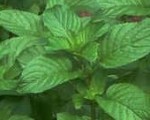 Evidence from the ancient civilizations of both Egypt and China attest to the fact that man has enjoyed herbal teas for thousands of years. Herbal teas can be made from the flowers, leaves, stems, or roots, depending on the herb. Some are consumed hot, others cold; some are consumed simply for their good flavors, other for the health benefits they may provide. Of course, many are drunk for both reasons. A selection of herbal teas can be found in most grocery stores but why not try growing your own herbs and make the tea?
Evidence from the ancient civilizations of both Egypt and China attest to the fact that man has enjoyed herbal teas for thousands of years. Herbal teas can be made from the flowers, leaves, stems, or roots, depending on the herb. Some are consumed hot, others cold; some are consumed simply for their good flavors, other for the health benefits they may provide. Of course, many are drunk for both reasons. A selection of herbal teas can be found in most grocery stores but why not try growing your own herbs and make the tea?
Here are five herbs that are easy to grow and readily available.
 Camomile (Chamaemelum noble)
Camomile (Chamaemelum noble)
Probably the most well-known of the herbal teas from Peter Rabbit lore, chamomile tea is made from the daisy like flowers. They make a tasty tea that with an apple fragrance and is said to induce sleep. Culpepper noted that it also “easeth…all pain and torments of the belly.”
-
Type: Perennial
Height: 12”
Light: Full sun to partial shade
Soil:Average, well-drained, pH 6-7
Hardiness: Zones 4-8
 Peppermint (Mentha x piperita)
Peppermint (Mentha x piperita)
Peppermint is the mint that is used to flavor candy, gum, and a variety of other sweets. It is stronger than spearmint and the best mint to use for tea. Young leaves are best as older leaves may grow bitter. Peppermint tea is tasty hot or cold and has many reputed health benefits especially related to digestion. Culpepper noted that it “is useful for complaints of the stomach, such as wind, vomiting, etc., for which there are few remedies of greater efficacy.”
-
Type: Perennial
Height: 12-18”
Light: Full sun to partial shade
Soil: Fertile, moist, well-drained, pH 6.5
Hardiness: Zones 5-11
 Sweet Woodruff (Galium odoratum)
Sweet Woodruff (Galium odoratum)
In Germany sweet woodruff is used to flavor May wine but a refreshing tea can be made from its flowers and leaves that have a light, grassy, vanilla flavor. It is best drunk cold with a slice of lemon and a little honey. It makes a great ground cover in a shady garden bearing dainty flowers in early spring.
-
Type: Perennial
Height: 8”
Light: Shade
Soil: Humus rich, moist, well-drained
Hardiness: Zones 4-8
 Bergamot (Monarda didyma)
Bergamot (Monarda didyma)
The Indians of the area around Otsego (aka Oswego) introduced the pioneers to their tea made from bergamot and it became quite popular among the early colonists after the Boston Tea Party when black tea was in short supply. Its orange-lemon citrus flavor is often used to enhance other teas as well as a variety of foods. Tea can be made from the flowers and leaves and is said to induce sleep.
-
Type: Perennial
Height: 3-4’
Light: Full sun to partial shade
Soil: Fertile, moist, pH 6.5
Hardiness: Zones 4-9
 Lemon Verbena (Aloysia triphylla)
Lemon Verbena (Aloysia triphylla)
Best known for its lemony aroma that was to favorite sent of Scarlet O’Hara’s mother, lemon verbena leaves make a delicately flavored lemon-lime tea that is said to aid digestion and act as a sedative. The plant is shrubby an cold sensitive so is usually grown as a houseplant.
-
Type: Tender perennial
Height: 10-15’; 5’ in a pot
Light: Full sun
Soil: Fertile, moist, well-drained
Hardiness: Zones 9-10
Herbal teas are generally made by adding boiling water to the herbal material in a nonmetal container and letting it brew for at least five minutes. For each cup of water about one tablespoon of dried herb or two tablespoons of fresh herb is used, plus a tablespoon “for the pot”. The exact steeping time varies with the herb so tasting at intervals is recommended. When the desired strength is reached, the tea is strained. Honey is the traditional sweetener of choice and slices of lemon, orange, or a sprig of herb, a pleasant garnish.
